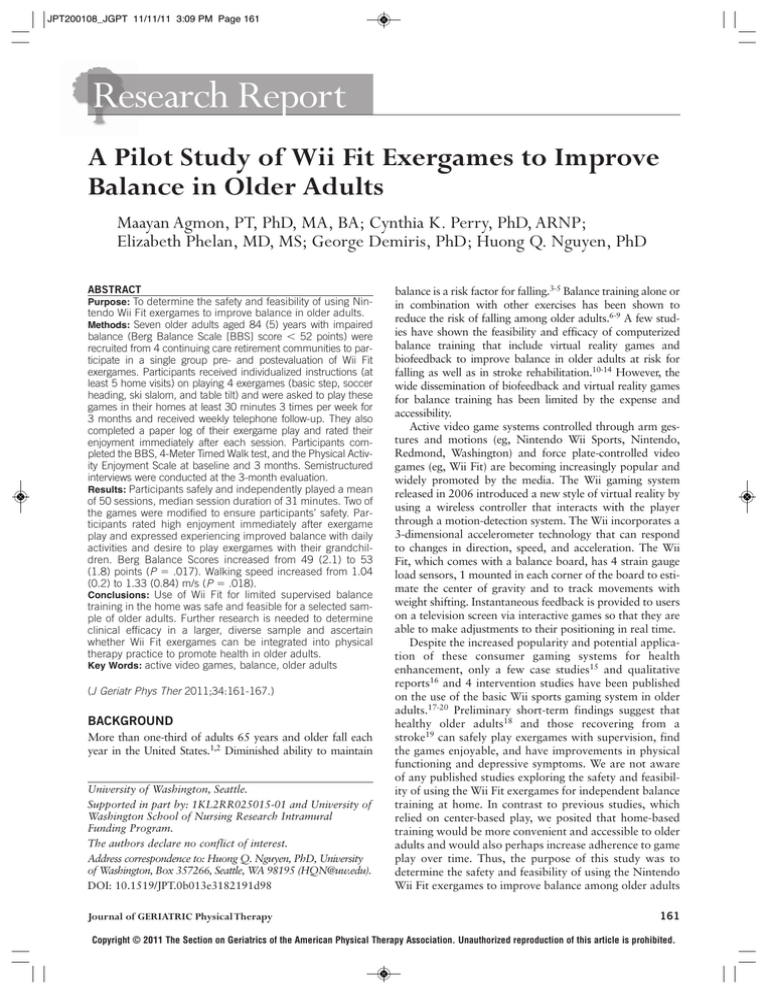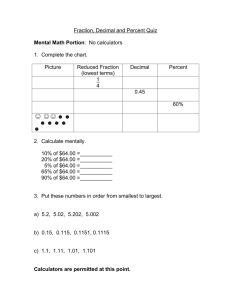Research Report
advertisement

JPT200108_JGPT 11/11/11 3:09 PM Page 161 Research Report A Pilot Study of Wii Fit Exergames to Improve Balance in Older Adults Maayan Agmon, PT, PhD, MA, BA; Cynthia K. Perry, PhD, ARNP; Elizabeth Phelan, MD, MS; George Demiris, PhD; Huong Q. Nguyen, PhD ABSTRACT Purpose: To determine the safety and feasibility of using Nintendo Wii Fit exergames to improve balance in older adults. Methods: Seven older adults aged 84 (5) years with impaired balance (Berg Balance Scale [BBS] score ⬍ 52 points) were recruited from 4 continuing care retirement communities to participate in a single group pre- and postevaluation of Wii Fit exergames. Participants received individualized instructions (at least 5 home visits) on playing 4 exergames (basic step, soccer heading, ski slalom, and table tilt) and were asked to play these games in their homes at least 30 minutes 3 times per week for 3 months and received weekly telephone follow-up. They also completed a paper log of their exergame play and rated their enjoyment immediately after each session. Participants completed the BBS, 4-Meter Timed Walk test, and the Physical Activity Enjoyment Scale at baseline and 3 months. Semistructured interviews were conducted at the 3-month evaluation. Results: Participants safely and independently played a mean of 50 sessions, median session duration of 31 minutes. Two of the games were modified to ensure participants’ safety. Participants rated high enjoyment immediately after exergame play and expressed experiencing improved balance with daily activities and desire to play exergames with their grandchildren. Berg Balance Scores increased from 49 (2.1) to 53 (1.8) points (P ⫽ .017). Walking speed increased from 1.04 (0.2) to 1.33 (0.84) m/s (P ⫽ .018). Conclusions: Use of Wii Fit for limited supervised balance training in the home was safe and feasible for a selected sample of older adults. Further research is needed to determine clinical efficacy in a larger, diverse sample and ascertain whether Wii Fit exergames can be integrated into physical therapy practice to promote health in older adults. Key Words: active video games, balance, older adults (J Geriatr Phys Ther 2011;34:161-167.) BACKGROUND More than one-third of adults 65 years and older fall each year in the United States.1,2 Diminished ability to maintain University of Washington, Seattle. Supported in part by: 1KL2RR025015-01 and University of Washington School of Nursing Research Intramural Funding Program. The authors declare no conflict of interest. Address correspondence to: Huong Q. Nguyen, PhD, University of Washington, Box 357266, Seattle, WA 98195 (HQN@uw.edu). DOI: 10.1519/JPT.0b013e3182191d98 Journal of GERIATRIC Physical Therapy balance is a risk factor for falling.3-5 Balance training alone or in combination with other exercises has been shown to reduce the risk of falling among older adults.6-9 A few studies have shown the feasibility and efficacy of computerized balance training that include virtual reality games and biofeedback to improve balance in older adults at risk for falling as well as in stroke rehabilitation.10-14 However, the wide dissemination of biofeedback and virtual reality games for balance training has been limited by the expense and accessibility. Active video game systems controlled through arm gestures and motions (eg, Nintendo Wii Sports, Nintendo, Redmond, Washington) and force plate-controlled video games (eg, Wii Fit) are becoming increasingly popular and widely promoted by the media. The Wii gaming system released in 2006 introduced a new style of virtual reality by using a wireless controller that interacts with the player through a motion-detection system. The Wii incorporates a 3-dimensional accelerometer technology that can respond to changes in direction, speed, and acceleration. The Wii Fit, which comes with a balance board, has 4 strain gauge load sensors, 1 mounted in each corner of the board to estimate the center of gravity and to track movements with weight shifting. Instantaneous feedback is provided to users on a television screen via interactive games so that they are able to make adjustments to their positioning in real time. Despite the increased popularity and potential application of these consumer gaming systems for health enhancement, only a few case studies15 and qualitative reports16 and 4 intervention studies have been published on the use of the basic Wii sports gaming system in older adults.17-20 Preliminary short-term findings suggest that healthy older adults18 and those recovering from a stroke19 can safely play exergames with supervision, find the games enjoyable, and have improvements in physical functioning and depressive symptoms. We are not aware of any published studies exploring the safety and feasibility of using the Wii Fit exergames for independent balance training at home. In contrast to previous studies, which relied on center-based play, we posited that home-based training would be more convenient and accessible to older adults and would also perhaps increase adherence to game play over time. Thus, the purpose of this study was to determine the safety and feasibility of using the Nintendo Wii Fit exergames to improve balance among older adults 161 Copyright © 2011 The Section on Geriatrics of the American Physical Therapy Association. Unauthorized reproduction of this article is prohibited. JPT200108_JGPT 11/11/11 3:10 PM Page 162 Research Report with balance impairments in a 3-month individualized home-based training program. METHODS Study Design This study used a quasiexperimental single-group pre-post design to determine the feasibility and preliminary efficacy of the Nintendo Wii Fit exergames to improve balance. The study was approved by the institutional review board at the University of Washington. Recruitment Four 1-hour information-demonstration sessions were conducted at 4 continuing care retirement facilities in the greater Seattle, Washington area. One to 2 weeks before the information session, study brochures were distributed to each resident and announcements were posted at prominent locations in the facilities and on the activities calendar. A total of 93 residents attended the information sessions. Thirty-nine residents expressed an interest in the study and were subsequently screened for study eligibility either in person during the information session or thereafter, over the telephone. Sample To be included in the study, potential participants had to be 65 years of age or older, have a score of less than 52 on the Berg Balance Scale (BBS)21 (indicative of impaired balance),22-24 be able to walk 4 meters without human support or assistive device, have approval from the participant’s health care provider, have a working television set in their home, and have adequate vision and hearing to interact with the games. Potential participants were excluded if there were evidence of cognitive impairment (Brief Screen for Cognitive Impairment, score ⬎4),25 significant musculoskeletal or neurologic deficit (eg, cerebral vascular accident and routine use of walkers or other assistive devices), visual and auditory impairment that would place the participant at high risk for falling with unsupervised exercise, as judged by the research staff, or have active self-reported symptomatic illness (eg, cancer, class III-IV congestive heart failure, severe chronic obstructive pulmonary disease, ischemic heart disease, and/or psychiatric illness). Study Procedures The baseline visit that was conducted by M.A., H.Q.N. or C.K.P. included the following: (1) informed consent; (2) completion of baseline screening/testing that included the BBS, Timed 4-Meter Walk test, and paper questionnaires; (3) setting up the Wii Fit console; and (4) short orientation to the Wii Fit balance exergames. A graduate-level trained physical therapist (M.A.) served as the trainer and interventionist. The first training session was scheduled 2 days later, followed by 4 additional training sessions in the first week of enrollment. Follow-up telephone calls were made weekly over the subsequent 3 months by M.A. The 3-month evaluation visit and semistructured exit interviews were conducted by H.Q.N. and C.K.P., who were not involved with the training and intervention. Wii Fit Balance Training Intervention Participants were instructed to play the balance exergames for 30 minutes per session at least 3 times per week for 3 months. Each 30-minute session included performance of at least 3 sets of balance games of the 4 possible games (basic step, soccer heading, ski slalom, and table tilt). A detailed description of each exergame and its specific effects on balance are included in Table 1. Participants were supervised by the physical therapist until they felt comfortable and confident using the Wii Fit independently and safely. We anticipated that this would require up to 5 supervised training sessions. The interventionist conducted 5-10–minute telephone calls with participants on a weekly basis to encourage adherence and adjust the training program, for example, modify the games to ensure safety, challenging Table 1. Description of Wii Fit Exergames Balance game General description and scoring Basic step Participants follow a step sequence on the television Time: 2.5 min per game ⫻ 3 games screen by stepping on and off the balance board Total minutes: 10 min with 1-min rest between (forward/backward and side to side) each step game Scoring: number of synchronized steps Therapeutic goals Warm up and low-moderate intensity aerobic exercise Dynamic balance Attention and coordination Visual and auditory feedback Participants move their center of gravity to strike Soccer heading virtual soccer balls coming at them from the Static balance and quick motor response Time: 1 min per game ⫻ 6 games television screen Attention and coordination Total minutes: 10 min with 1-min rest between Scoring: number of soccer ball strikes and avoiding Visual and auditory feedback 2 games, as needed diversions Ski slalom Participants ski downhill between poles while flexing Static balance and whole-body movement Time: 1 min per game ⫻ 6 games their knees and shifting their weight Attention and coordination Total minutes: 10 min with 1-min rest between Scoring: speed and accuracy with skiing between Visual and auditory feedback 2 games, as needed poles Table tilt Time: variable, depending on performance Total minutes: 10 min with rest as needed. 162 Participants tilt their center of gravity to direct Static balance and motor response balls into a hole on a shifting platform Visual and auditory feedback Scoring: number of balls that enter the hole. Volume 34 • Number 4 • October-December 2011 Copyright © 2011 The Section on Geriatrics of the American Physical Therapy Association. Unauthorized reproduction of this article is prohibited. JPT200108_JGPT 11/11/11 3:10 PM Page 163 Research Report participants to increase the game’s difficulty level, as well as troubleshoot any technical difficulties. The residential activity coordinators at each continuing care community were also available to assist participants with simple technical issues, as needed. All 3 coordinators were already familiar with the Wii gaming console since the facilities had used the console for group gaming activities. Participants were encouraged to select a specific time that was convenient for regular practice to establish a routine and improve adherence over the 3-month study. Measurements Demographic (age, gender, race/ethnicity, education, and marital status) and health status (self-rated health and number of chronic medical conditions) data were collected at the baseline visit via self-report. Weight was measured with the Wii Fit balance board and height by self-report. Total step count was measured over 5 days at baseline by using a pagersized, lightweight, Stepwatch 3 Activity Monitor (OrthoCare Innovations, Washington, District of Columbia) fastened above the right ankle. Step counts provided descriptive information on the participants’ level of physical activity.26 Balance, Gait Speed, and Exercise Enjoyment Balance The BBS was chosen to assess the primary study outcome because it measures both static and dynamic balance, has high interrater reliability (0.98) and internal consistency (0.96), and has been shown to be responsive to change as a result of balance training interventions.21 The BBS measures 14 increasingly difficult mobility tasks, for example, ability to sit, stand, reach, lean over, turn and look over each shoulder, turn in a complete circle, and step, which are graded on a scale of 0 to 4, with the highest score of 56 points. An improvement of 4 points has been considered to be a minimal clinically important difference.27 Timed 4-Meter Walk test This walk test served as both a baseline screen for mobility impairment (inability to walk without human support or assistive device) and a measure of gait speed, which is predictive of disability and mortality.28,29 Participants were asked to walk a 4-meter (13-foot) straight course as fast as possible (due to a data collection error, we only had change scores for fast walking pace) with an allowance of 2 feet for acceleration and deceleration. Participants performed this test once at baseline and twice at the 3-month posttest with a 1-minute rest period in between. The range of fast walk speed for older adults is 1.1 to 1.2 m/s.30 Exercise Enjoyment The Physical Activity Enjoyment Scale (PACES) was used to measure exercise enjoyment. The scale consists of 18 statements describing bipolar responses associated with physical activity (eg, exciting and/or boring) by using a 7-point Likert response option. Responses were coded, where lower scores indicated greater enjoyment, with scores ranging Journal of GERIATRIC Physical Therapy from 18 to 126.31 Internal consistency, as measured by Cronbach ␣ was 0.92 in the present study. Feasibility and Safety Frequency and duration of time for playing exergames, safety, and technical difficulties were monitored with semistructured weekly phone calls and written logs. During the phone calls, participants were asked specifically about their general health, injuries and difficulties with game play, frequency and duration of play, and enjoyment and game preference. Participants completed a short log of their exercise at the end of each session that included duration of time, exercise games played, and scores. They also answered 4 questions from the PACES on how they felt about playing the Wii Fit games at that time (I enjoy it; I find it energizing; I feel physically good while doing it; and/or it gives me a strong sense of accomplishment). A semistructured interview lasting approximately 10 minutes was conducted with each participant at the 3-month posttest home visit. Analysis Content analysis was used to identify important themes and concepts from the home visit logs, telephone calls, and exit interviews. All field notes and documentation were reviewed separately by H.Q.N and M.A. initially. The investigators then met to discuss and conferred on the general themes that emerged to ensure consistency and fidelity of the findings. Themes from the exit interviews were triangulated with the field notes, and documentation made by M.A. during the intervention period. The Wilcoxon signedrank test was used to explore changes in the BBS, Timed Walk test, and exercise enjoyment from baseline to 3 months. Linear regressions with a clustering function were used to determine the mean slope of change in Wii Fit game scores for all participants. The clustering function was used since participants contributed varying amounts of data based on the frequency of game play. All analyses were conducted in STATA v.10 (StataCorp, College Station, Texas). RESULTS A total of 39 residents expressed an interest in being further screened for the study. Individuals were excluded for the following reasons: (1) no balance impairment based on BBS test (n ⫽ 3); (2) unable to obtain health care provider approval (n ⫽ 1); (3) decided not to enroll (n ⫽ 1); (4) withdrew after the first home visit due to other competing demands (n ⫽ 1); (5) medical conditions that would make the unsupervised exergame exercises unsafe, for example, symptomatic illness and musculoskeletal and neurological deficits (n ⫽ 26). This resulted in a total sample size of 7. The sample characteristics for the 7 participants who enrolled and completed the study are described in Table 2. Wii Fit Exergame Play On the basis of the paper diaries, participants logged a mean of 50 unique play sessions (range, 31-68) with a median duration of 31 minutes (range, 10 minutes to 163 Copyright © 2011 The Section on Geriatrics of the American Physical Therapy Association. Unauthorized reproduction of this article is prohibited. JPT200108_JGPT 11/11/11 3:10 PM Page 164 Research Report Table 2. Baseline Sample Characteristics (n ⴝ 7)a Mean (SD)/Frequency Demographics Age 84 (5); range, 78-92 Female 4 College educated or higher 4 Race/ethnicity Caucasian 5 African-American 1 Asian 1 Married/partnered 2 Live alone 4 Retired, not working Body mass index 7 27.4 (3.3) Health status (self-rated health) Excellent/very good 3 Good 4 ⱖ2 chronic conditions 3 Fall in past 12 months 4 Total steps per dayb 5495 (1800) improved safety with game play, it was discouraging for participants because the balance board only recognized and scored deliberate steps and not foot tapping. Both participants were then encouraged to hold onto the back of a sturdy chair for stability so that they could safely step up and down on the board. Although this approach allowed for their steps to be recorded and scored, the participants might have not sufficiently challenged their balance. Additional home visits, which lasted up to 30 minutes, were made to 4 participants 1 month into the intervention in response to participants’ requests for feedback and corrections on their techniques. Two participants complained of neck strain with the soccer heading game. While playing the game, participants made sharp side-to-side jerky movements of their neck and head. The interventionist showed them how to shift their weight instead of moving their neck. Despite this additional training, both participants continued to have difficulty with the game. Therefore, they were advised to stop playing this game after 20 sessions. Four participants reported being unsteady with their balance when side stepping off the balance board on the step game. One reported hip strain, which she attributed to an old hip injury. All 4 participants were encouraged to step forward and backward and not side to side on the balance board. None of the participants experienced a fall during the study. aSelf-reported chronic conditions are arthritis, hypertension, asthma, previous heart attack, coronary artery disease, stroke, diabetes, asthma, and COPD. classification for healthy adults: (i) ⬍5000 steps per day: “sedentary lifestyle”; (ii) 5000-7499 steps per day: “low active”; (iii) 7500-9999 “somewhat active”; (iv) ⱖ10000 steps per day: “active”; and (v) ⬎12500 steps per day “highly active.”26 bActivity 2 hours) per session during the 3 months. The automated date and time stamps from the Wii console (median play time per session ⫽ 33 minutes) were similar to participants’ self-report of play duration. Participants reported a high level of enjoyment (mean [SD] ⫽ 2.6 [0.9]; lower scores on 1-7–point scale indicated higher enjoyment) after each play session. While there was a range in participant performance on the 4 Wii Fit exergames at the start, all participants showed incremental linear improvements in their raw game scores during the 3 months, as reflected in the individual “beta coefficients” (Table 3). Feasibility, Safety, and Technical Issues All participants felt comfortable in using the Wii Fit after receiving 5 individualized training sessions with the interventionist. Each training session lasted 45 to 60 minutes. Participants initially had difficulty navigating from the television setting to the game console and through the layered menu on the Wii Fit to play the exergames. A shortcut under “My Wii Fit favorites” was set up for all the participants to improve navigation. Two participants had trouble maintaining their balance with the steps game during the training visits; this game required players to step on and off the balance board. To ensure safety and to help to build their rhythm and confidence, they were instructed to tap their foot on the board instead of making a complete step. While this strategy 164 Qualitative Findings We identified 3 major themes based on notes gathered from participants’ observation during the home training visits, weekly phone calls, and exit interviews. Indicators of improved balance Participants described their improvement based on changes in functioning in their daily life and changes in their game scores. In terms of their daily living, one participant commented, “I can now stand on one foot to put on my undergarment.” Another participant said, “I felt that my balance improved and I felt stronger too, I don’t stumble against the wall.” A third participant said, “Because I felt improvement with the Wii Fit, I was motivated to join EnhanceFitness [a group exercise class].” She was reluctant to participate in the group exercise class before playing the Wii Fit because she felt that her balance was too poor. Three other participants said that they felt overall improvement but were not able to provide specific examples. A partner of 1 participant who was not invited to participate in the interview but chimed in from the background, “He is more definite in his steps; I see less shuffling and he seems to be more assured when walking.” Only 1 participant reported no improvement. Participants also gauged their improvement based on game scores. They pointed out that keeping a paper dairy was useful because it helped them review their progress and see visible improvement in their scores. Three participants reported experimenting with the timing of their exergame play to optimize their performance; they all commented that their best performance was in the morning. Volume 34 • Number 4 • October-December 2011 Copyright © 2011 The Section on Geriatrics of the American Physical Therapy Association. Unauthorized reproduction of this article is prohibited. JPT200108_JGPT 11/11/11 3:10 PM Page 165 Research Report Table 3. Change in Wii Fit Exergame Scores Over 3 Months Basic step Soccer heading Ski slalom Table tilt Constanta b Constanta b Constanta b Constanta b 1 173 1.15 14.77 .47 1.42 ⫺.004 23.8 .37 2 84 4.4 ⫺1.6 1.60 1.34 ⫺.015 44.7 .30 3 125 .96 12.4 .13 2.00 ⫺.013 28.6 .35 4 149 1.2 17.3 1.2 3.6 ⫺.009 29.2 1.8 5 156 .57 19.4 .82 1.37 ⫺.014 34.7 .50 6 87 1.7 21 .75 1.04 ⫺.016 36.3 .56 7 141 3.1 7.12 1.22 1.14 ⫺.145 23.2 1.50 All 143 1.3c (.25-2.4) 8.7 1.2c (.82-1.6) 1.78 ⫺.014c (⫺.02 to .01) 26.5 1.07c (.04-2.1) Subject aConstant: Baseline game score. Slope of improvement in raw game score over 3 months (95% confidence interval). ⬍ .05: For example, change in game score with each consecutive game is significantly different from zero. b: cP Game preference All participants reported that the tilt board and the ski slalom were their favorite games because they easily understood the scoring for the games and they felt and saw visible progress. Five participants were discouraged by the soccer heading game because of the fast pace, inability to distinguish their targets, for example, soccer balls versus distracters, and lack of improvement in scores. All participants reported feeling tired after one 3-minute session of the step game due to the cardiovascular demand. Family participation and support Six participants described that they enjoyed playing the Wii Fit with their grandchildren when they visited. One participant said that her family was planning to buy her a Wii Fit for her birthday. Another asked if she could continue to keep the Wii Fit for an indefinite loan because she wanted to continue to play with her grandchildren. Exploratory Changes in Balance, Gait Speed, and Physical Activity Enjoyment There were improvements in the BBS (mean [SD], 49 [2.1]53 [1.8] points; P ⫽ .017) (Figure 1) and gait speed (mean [SD], 1.04 [0.2]-1.33 [0.84] m/s; P ⫽ .018). Four participants met the minimal clinically important difference for the BBS. There were no changes in physical activity enjoy- Figure 1. Changes in Berg Balance Scale after 3 months of Wii Fit training (n ⫽ 7). Journal of GERIATRIC Physical Therapy ment as measured by the PACES (mean [SD], 45 [19]-40 [18]; P ⫽ .61]. DISCUSSION This study suggests that it is safe and feasible for older adults with impaired balance to participate in a 3-month homebased, limited-supervision balance training intervention using a commercially available active gaming console, Nintendo Wii Fit. Participants enjoyed playing the exergames and found the games motivating. Moreover, there was preliminary indication that the Wii Fit exergames improved balance, as measured by the BBS. Our findings that the Wii Fit balance exergames are safe and feasible for older adults have several caveats. First, we excluded a large number of prospective participants, primarily due to musculoskeletal and neurological deficits and symptomatic disease, for example, exclusive use of walkers, vertigo, chest pain, etc. Since the intervention was considered to be very new and participants were asked to engage in mostly unsupervised play, we wanted to be more conservative to reduce the risk of injury. Second, we initially estimated that five 30-minute training visits in the first week would be sufficient to ensure that participants were comfortable and confident with playing the games independently. However, it was evident that additional periodic visits were necessary beyond the weekly phone follow-ups to provide reinforcement, especially when participants were experiencing frustration with their lack of progress and to help participants modify game play when they experienced musculoskeletal strain. Most participants reported that they “got a hang” of the games by the end of the second month. The incremental improvements in the game scores over the 3 months also reflect their increased mastery of the games. Future studies will need to incorporate ongoing home visits to support successful and sustained independent game play beyond the initial training for older adults if these games are used for rehabilitation purposes. Third, we had to modify and/or ask participants to discontinue 2 of the games (basic step and soccer heading) due 165 Copyright © 2011 The Section on Geriatrics of the American Physical Therapy Association. Unauthorized reproduction of this article is prohibited. JPT200108_JGPT 11/11/11 3:10 PM Page 166 Research Report to safety concerns and muscle strain, respectively. Perhaps with additional close supervision and training, we would have been able to progress these participants to play these 2 games as they were designed. It is unclear that if participants had fully engaged in all the 4 exergames, then whether the changes in balance would have been more substantial or whether dedicated play with a particular game was more efficacious in improving balance. We were able to retrieve data only on the cumulative duration of play for a particular day from the Wii console to cross-validate with the self-report paper logs. Because detailed information on the duration and frequency of game play were inaccessible from the console, we could not precisely determine the optimal training “dose” from this feasibility study. Although there was no significant change in overall exercise enjoyment from baseline to 3 months, enjoyment measured immediately after each exergame session was high. One recent laboratory study showed that while energy expenditure with Wii balance exergame was lower compared with walking on a treadmill, enjoyment was rated significantly higher with exergame play in a small sample of older adults.32 Enjoyment has been found to be associated with increased adherence to exercise over time.33-35 The improvement in balance and gait speed may have been spurious, given the small sample and lack of a control group. However, the qualitative findings where participants noted improvement in balance with daily activities suggest that the changes as measured by the BBS may be real. Nonetheless, future studies will need to confirm these findings by using the BBS, other validated measures of balance, and follow participants over time to monitor for actual falls. A majority of participants reported playing the Wii Fit with their grandchildren. Although the intervention was designed for participants to play alone, leveraging older adults’ social network and encouraging intergenerational play could increase engagement and motivation.36 Interestingly, a recent study by Rosenberg et al,18 which tested the effects of a 3-month Wii Sports intervention in older adults with subsyndromal depression, suggests that game play with others, in a group setting, may have positive effects on depressive symptoms, mental health–related quality of life, and cognitive performance. Limitations of this study are several. First, it involved a very small, self-selected sample of older persons with mild balance impairment, of whom more than half were college educated; this sample is unlikely to be representative of the entire spectrum of older adults, and so further, feasibility testing with other potential Wii Fit users from a more varied socioeconomic background and with a broader range of balance impairment is warranted. Second, because of the lack of a control group, we cannot confirm that the change in balance and gait speed we observed occurred as a result of the Wii Fit intervention. Third, we did not have an access to detailed data on actual game play from the Wii console to quantify the optimal training “dose.” Lastly, the shortterm follow-up limited assessment of outcomes to those that would be expected to occur proximal to the interven166 tion; longer-term effects of the intervention could not be ascertained. CONCLUSIONS The overall findings from this feasibility study suggest that older adults are likely to need close guidance and supervision if they are to successfully use the Wii Fit to improve balance in their homes. While the small sample size, highly selected participants, lack of a control group, short-term follow-up, and lack of detailed data on game play represent important limitations of this exploratory study, the findings that older adults can safely play the exergames with limited supervision and potentially have positive improvement in balance suggest a promising novel, relatively low-cost option for balance training that deserves further consideration. REFERENCES 1. Hausdorff JM, Rios DA, Edelberg HK. Gait variability and fall risk in communityliving older adults: a 1-year prospective study. Arch Phys Med Rehabil . 2001;82:1050-1056. 2. Stevens J, Mack K, Paulozzi L, Ballesteros M. Self-reported falls and fall-related injuries among persons aged ⬎65 years—United States, 2006. MMWR Morb Mortal Wkly Rep. 2008;57:225-229. 3. Summary of the Updated American Geriatrics Society/British Geriatrics Society clinical practice guideline for prevention of falls in older persons. J Am Geriatr Soc. 2011;59:148-157. 4. Delbaere K, Close JC, Heim J, et al. A multifactorial approach to understanding fall risk in older people. J Am Geriatr Soc. 2010;58:1679-1685. 5. Tinetti ME, Kumar C. The patient who falls: “It’s always a trade-off”. JAMA. 2010;303:258-266. 6. Sherrington C, Whitney JC, Lord SR, Herbert RD, Cumming RG, Close JC. Effective exercise for the prevention of falls: a systematic review and meta-analysis. J Am Geriatr Soc. 2008;56:2234-2243. 7. Gillespie LD, Robertson MC, Gillespie WJ, et al. Interventions for preventing falls in older people living in the community. Cochrane Database Syst Rev . 2009;(2):CD007146. 8. Stevens J, Sogolow E. Preventing falls: What Works. A CDC Compendium of Effective Community-Based Interventions From Around the World. Atlanta, GA: Centers for Disease Control and Prevention, National Center for Injury Prevention and Control; 2008. 9. Howe TE, Rochester L, Jackson A, Banks PM, Blair VA. Exercise for improving balance in older people. Cochrane Database Syst Rev. 2007;(4):CD004963. 10. Eser F, Yavuzer G, Karakus D, Karaoglan B. The effect of balance training on motor recovery and ambulation after stroke: a randomized controlled trial. Eur J Phys Rehabil Med. 2008;44:19-25. 11. Wolf SL, Barnhart HX, Kutner NG, McNeely E, Coogler C, Xu T. Reducing frailty and falls in older persons: an investigation of Tai Chi and computerized balance training. Atlanta FICSIT Group. Frailty and injuries: cooperative studies of intervention techniques. J Am Geriatr Soc. 1996;44:489-497. 12. Heiden E, Lajoie Y. Games-based biofeedback training and the attentional demands of balance in older adults. Aging Clin Exp Res. 2010;22:367-73. 13. Yavuzer G, Senel A, Atay MB, Stam HJ. ‘’Playstation eyetoy games’’ improve upper extremity-related motor functioning in subacute stroke: a randomized controlled clinical trial. Eur J Phys Rehabil Med. 2008;44:237-424. 14. Bisson E, Contant B, Sveistrup H, Lajoie Y. Functional balance and dual-task reaction times in older adults are improved by virtual reality and biofeedback training. Cyberpsychol Behav. 2007;10:16-23. 15. Clark R, Kraemer T. Clinical use of Nintendo Wii bowling simulation to decrease fall risk in an elderly resident of a nursing home: a case report. J Geriatr Phys Ther. 2009;32:174-180. 16. Marshall S, Nicaise V, Lorenz K, et al. Old dogs and new tricks: a qualitative study of older adults’ experiences with exergames. In: Society for Behavioral Medicine Annual Conference. Seattle, WA; 2010. 17. Hsu JK, Thibodeau R, Wong SJ, Zukiwsky D, Cecile S, Walton DM. A “Wii” bit of fun: the effects of adding Nintendo Wii(R) Bowling to a standard exercise regimen for residents of long-term care with upper extremity dysfunction. Physiother Theory Pract. 2011;27:185-93. 18. Rosenberg D, Depp CA, Vahia IV, et al. Exergames for subsyndromal depression in older adults: a pilot study of a novel intervention. Am J Geriatr Psychiatry. 2010;18:221-226. 19. Saposnik G, Teasell R, Mamdani M, et al. Effectiveness of virtual reality using Wii gaming technology in stroke rehabilitation: a pilot randomized clinical trial and proof of principle. Stroke. 2010;41:1477-1484. 20. Yong Joo L, Soon Y, Xu D, et al. A feasibility study using interactive commercial off-the-shelf computer gaming in upper limb rehabilitation in patients after stroke. J Rehabil Med. 2010;42:437-441. Volume 34 • Number 4 • October-December 2011 Copyright © 2011 The Section on Geriatrics of the American Physical Therapy Association. Unauthorized reproduction of this article is prohibited. JPT200108_JGPT 11/11/11 3:10 PM Page 167 Research Report 21. Berg KO, Wood-Dauphinee SL, Williams JI, Maki B. Measuring balance in the elderly: validation of an instrument. Can J Public Health. 1992;83(suppl)(2):S7S11. 22. Silsupadol P, Shumway-Cook A, Lugade V, et al. Effects of single-task versus dual-task training on balance performance in older adults: a double-blind, randomized controlled trial. Arch Phys Med Rehabil. 2009;90:381-387. 23. Silsupadol P, Lugade V, Shumway-Cook A, et al. Training-related changes in dual-task walking performance of elderly persons with balance impairment: a double-blind, randomized controlled trial. Gait Posture. 2009;29:634-639. 24. Shumway-Cook A, Baldwin M, Polissar NL, Gruber W. Predicting the probability for falls in community-dwelling older adults. Phys Ther. 1997;77:812819. 25. Hill J, McVay JM, Walter-Ginzburg A, et al. Validation of a brief screen for cognitive impairment (BSCI) administered by telephone for use in the Medicare population. Dis Manag. 2005;8:223-234. 26. Tudor-Locke C, Bassett DR, Jr. How many steps/day are enough? Preliminary pedometer indices for public health. Sports Med. 2004;34:1-8. 27. Donoghue D, Stokes EK. How much change is true change? The minimum detectable change of the Berg Balance Scale in elderly people. J Rehabil Med. 2009;41:343-346. 28. Guralnik JM, Ferrucci L, Simonsick EM, Salive ME, Wallace RB. Lower-extremity Journal of GERIATRIC Physical Therapy function in persons over the age of 70 years as a predictor of subsequent disability. N Engl J Med. 1995;332:556-561. 29. Studenski S, Perera S, Patel K, et al. Gait speed and survival in older adults. JAMA. 2011;305:50-58. 30. Bohannon RW. Comfortable and maximum walking speed of adults aged 2079 years: reference values and determinants. Age Ageing. 1997;26:15-19. 31. Kendzierski D, Decarlo K. Physical Activity Enjoyment Scale: two validation studies. J Sport Exerc Psychol. 1991;13:50-64. 32. Graves LE, Ridgers ND, Williams K, Stratton G, Atkinson G, Cable NT. The physiological cost and enjoyment of Wii Fit in adolescents, young adults, and older adults. J Phys Act Health. 2010;7:393-401. 33. Hagberg LA, Lindahl B, Nyberg L, Hellenius ML. Importance of enjoyment when promoting physical exercise. Scand J Med Sci Sports. 2009;19:740-747. 34. Huberty JL, Ransdell LB, Sidman C, et al. Explaining long-term exercise adherence in women who complete a structured exercise program. Res Q Exerc Sport. 2008;79:374-384. 35. McAuley E, Jerome GJ, Marquez DX, Elavsky S, Blissmer B. Exercise self-efficacy in older adults: social, affective, and behavioral influences. Ann Behav Med. 2003;25:1-7. 36. Rothman AJ. Toward a theory-based analysis of behavioral maintenance. Health Psychol. 2000;19:64-69. 167 Copyright © 2011 The Section on Geriatrics of the American Physical Therapy Association. Unauthorized reproduction of this article is prohibited.





